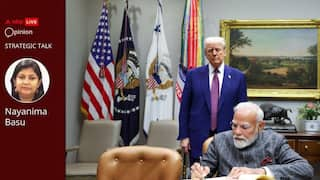Neighbourhood Watch: Will China Be Able To Steer Bhutan The Nepal Way?
Though Bhutan says it has neutral ties with China, its changing economy, transition from monarchy to democracy, and factors like China’s rise as a big power will have a bearing on its foreign policy.

The January 18-20 visit of India's Foreign Secretary Vinay Mohan Kwatra to Bhutan drew the attention of strategic observers, as it happened just a few days after the conclusion of the 24th round of Bhutan-China border talks, which China has been stretching for over three decades since 1984, almost parallel to the Sino-Indian border talks, which also commenced in 1983. Though foreign offices in Thimphu and New Delhi attributed the visit to the meeting of India-Bhutan border development talks, observers drew the obvious conclusion that it was intended to get a sense of the outcome of the latest Bhutan-China border talks held in Kunming (China) on January 13.
Though neither side has confirmed the discussions on the Bhutan-China border talks, it is understood that Bhutanese officials have given a detailed presentation of the latest round of the talks to the Indian foreign secretary.
ALSO READ | Neighbourhood Watch: Why India-China Ties May Plummet Further In 2023 With Security Taking Priority
Earlier, the joint statement of Bhutan and China, after the border talks, had said both sides have reached a positive consensus and decided to push forward border talks under the three-step roadmap, the contours of which have not yet been delineated publicly. The agreement reached during the October 2021 talks said this roadmap would provide a fresh impetus to border talks. According to the joint statement, both sides agreed to simultaneously push forward all the steps of three-step roadmap. Both sides also agreed to increase the frequency of the expert group meetings and to keep contact through diplomatic channels on holding the 25th round of China-Bhutan border talks as soon as possible. The release issued by both sides also revealed that the Chinese side handed over “donations of supplies” to the Bhutanese officials. Obviously, China was trying to induce the Bhutanese interlocutors. Till now, 11 rounds of expert group meetings and 24 rounds of border talks have failed to reach any concrete agreement.
Bhutan-China Talks: What Are India's Concerns?
The principal concern in India is that if Bhutan succumbs to Chinese pressure to resolve the boundary issue based on Chinese proposals or conditions through carrot and stick policy, not only Indian security interests would be hugely compromised but China will also try to later subjugate Bhutan and India would lose a buffer between India and China.
China is already trying to build its constituency in Bhutan, and voices have started to emerge in some sections of the Bhutanese polity that Thimphu should settle the issues with Beijing and move forward toward greater integration with the rest of the world, which will promote its national interests much better. This view is putting pressure on the Bhutanese foreign policy to have a special relationship with India. Though Bhutan says it has neutral relations with China, domestic developments like changing economy and transition from an absolute monarchy to a democracy, a generational shift and their exposure to the internet, and factors like China’s rise as an economic and military power will have a bearing on Bhutan’s foreign policy.
India had signed a Treaty of Friendship with Bhutan in 1949, and both neighbours give importance to a special relationship. Not to antagonise India, Bhutan maintains a distance with China and due to this has not yet agreed to have diplomatic relations with its gigantic neighbour. India has also taken care to look after Bhutan’s economic and security interests. It is well known that India provides security support to Bhutan. Though China has very often offered grants and loans to Bhutan, the landlocked country has refused. Since China has failed to convince Bhutan to come to its fold, it has been using various tactics to achieve its strategic goals to subjugate Bhutan.
Through Bhutan, China wants to kill two birds with one stone. First, it is following the strategy of pressurising Bhutan to accept its boundary proposals of swapping territories in Doklam, with territories on the northern side claimed by China. Second, If China gets control over Doklam, PLA would be able to gain strategic dominance overlooking the Siliguri corridor.
That Bhutan was considering a Chinese proposal for the exchange of territories, which included Doklam, was first revealed by the Bhutanese King himself while addressing the Bhutanese National Assembly in 1997. China has been claiming 764 sq km of Bhutanese territory, which included 269 sq km in northwestern areas comprising Doklam, Sinchulung, Dramana, and Shakhatoe. The rest of the 495 sq km is in North Central Bhutan comprising Pasamlung and Jakarlung valleys.
China had then proposed, and is still insisting on this proposal to be accepted, the exchange of Pasamlung and Jakarlung valleys with the Western Bhutan areas i.e. Doklam. China aimed at western areas as this would help them enlarge the narrow Chumbi valley and also provide them a bird's eye view of India’s north-eastern Siliguri corridor through Doklam. Bhutan had almost agreed to ink this territory exchange agreement in 2001, but the deal was scuttled when the Indian side came to know of this. This would have eased China’s strategic concerns over Chumbi valley and facilitated them advantage through the acquisition of Doklam. When New Delhi found out that the Chinese were building roads in Doklam in 2017, the Indian forces, in concurrence with Bhutan, were asked to stop the Chinese from building roads, which was challenged by China, resulting in 73 days' military standoff. To India’s relief, Bhutan is still holding on to its claim on Doklam. However, there are sections emerging in Thimphu asking for compromise with the Chinese.
Like India, Bhutan also signed maintenance of peace and tranquility on border areas with China in 1998, but the Chinese side has flagrantly violated the spirit of this agreement by encroaching on Bhutanese territories. China has not only built roads but also villages in the border areas, especially near Doklam. As this trijunction between India, Tibet, and Bhutan is of great strategic significance for India, Indian forces have stopped the advance of the Chinese army, but the two forces are positioned face to face, with heavy deployments on both sides.
Foreign Secretary Kwatra is reported to have been given an assurance by the Bhutanese authorities that they would not allow Indian strategic interests to be compromised, but there are concerns in India that Bhutan may go the Nepal way. Democratic politics in Bhutan may lead to a shift in Bhutan’s attitude towards China, as we have seen in Nepal and Sri Lanka which have courted China. And that's a good enough reason why India is in regular communication with the Bhutanese government on the Bhutan-China border talks.
The author is a senior journalist and strategic affairs analyst.
[Disclaimer: The opinions, beliefs, and views expressed by the various authors and forum participants on this website are personal.]






































